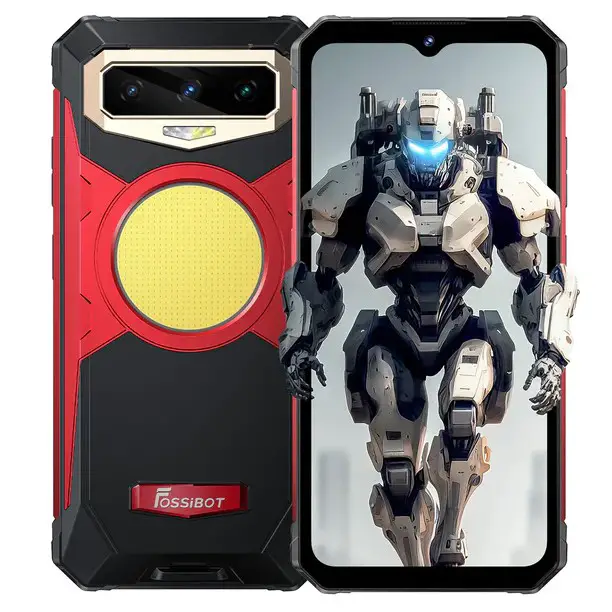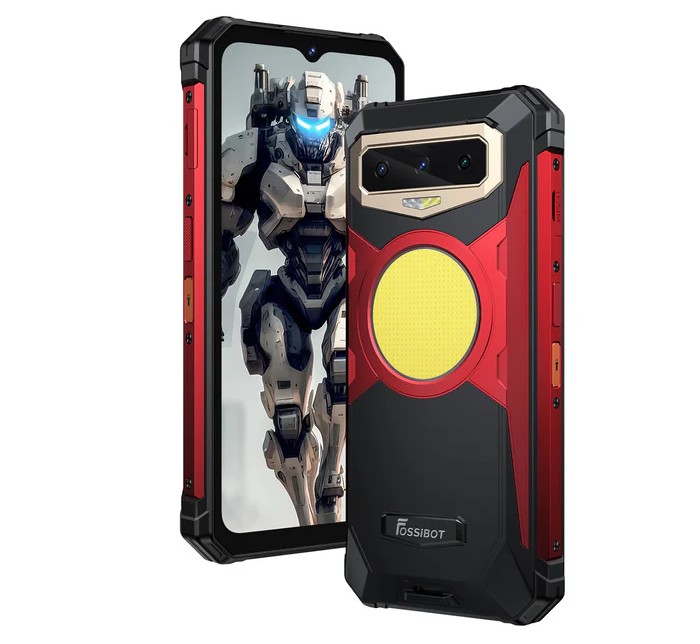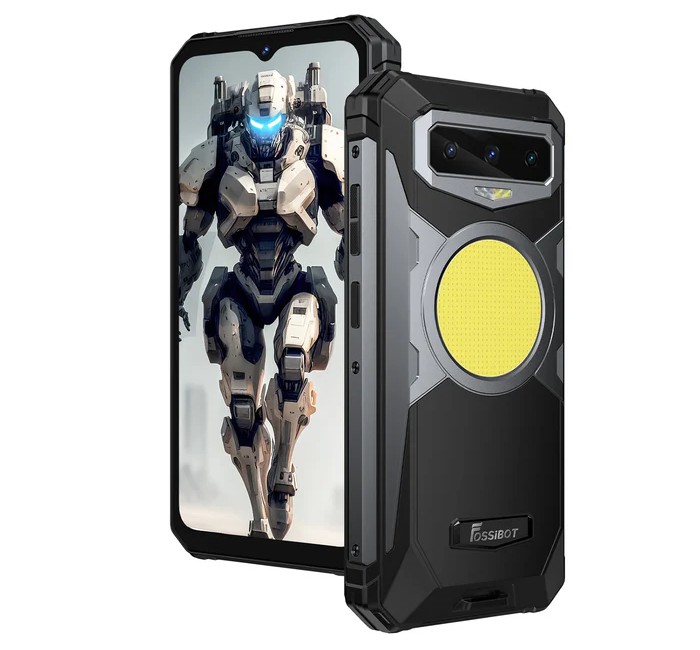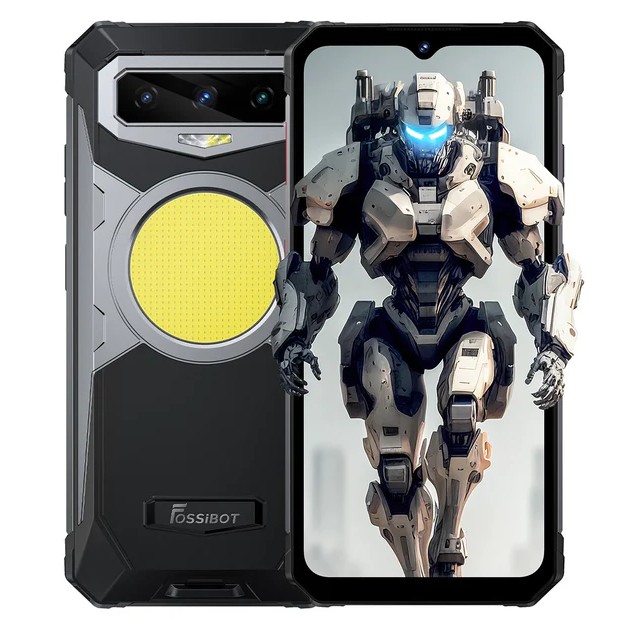




The Fossibot F102, released in September 2023, succeeds the F101 series, offering a significant upgrade in features such as better display, larger battery power, better camera specification and faster CPU power. Here's a closer look at its specifications:
Network
The F102 supports a wide range of 2G, 3G, and 4G network bands for global connectivity. This includes better 4G compatibility than the F101 series with additional bands like LTE Band 71. However, it's important to check compatibility with your specific carrier.
Durable Build
Like its predecessors, the F102 prioritizes durability. It features an IP68/IP69K dust and water resistance rating, and MIL-STD-810H certification ensures it can withstand drops. The phone is larger than the F101 Pro, measuring 172.3 x 82.6 x 25.6 mm and weighing 495 grams.
Large Display with High Refresh Rate
The F102 boasts a larger 6.58-inch TFT LCD touchscreen display with 16 million colors compared to the F101 Pro. It offers a sharper resolution of 1080 x 2408 pixels with a 20:9 aspect ratio and a higher pixel density of 401 PPI. Additionally, the display features a smooth 120Hz refresh rate for a more responsive user experience.
Recent Android OS & Powerful Performance
The F102 runs on the same Google Android 13 operating system as the F101 Pro. However, it packs a more powerful MediaTek Helio G99 chipset built on a 6nm process, offering improved performance.
The phone comes with a substantial 12GB of LPDDR4x RAM and 256GB of UFS 2.2 storage, with the option to virtually expand RAM by up to 8GB. Storage can also be further expanded with a microSD card up to 512GB, though this will take up the space for the second SIM card.
Enhanced Camera System
The camera system on the F102 is a significant upgrade over the F101 Pro. It features a high-resolution 108MP Samsung HM2 main sensor with a large 1/1.52" sensor size, PDAF, and an F/1.8 aperture for excellent low-light performance.
It also boasts a dedicated 20MP night vision sensor with an LED light for capturing clear images in dark environments. Additionally, there's a 5MP macro sensor for close-up shots and a 32MP Sony IMX616 sensor for high-quality selfies. The rear camera can record videos in up to 2K resolution at 30fps.
Improved Connectivity & Navigation
The F102 offers the latest Bluetooth 5.2 connectivity for faster data transfer and better range compared to the F101 Pro. It also supports standard WiFi 2.4G-5G and USB Type-C 2.0 for charging and data transfer. Navigation is aided by a wider range of global navigation satellite systems (A-GPS, GLONASS, BeiDou, Galileo, and QZSS). The phone includes essential sensors like an accelerometer, proximity sensor, and compass.
Massive Battery & Unique Features
The F102 outshines the F101 Pro with a much larger 16,500mAh Li-Po battery, offering extended usage time on a single charge. It also supports faster 33W fast charging for quicker replenishment. The F102 comes in black and red color options. Unlike the F101 Pro, it features dual stereo speakers for immersive audio.
A unique feature is the integrated 3W, 3-level adjustable camp light with 300 LEDs and a brightness of 495 Lumen, perfect for outdoor activities. The F102 also supports NFC for contactless payments and HAC for improved audio clarity in noisy environments.
While the Fossibot F102 boasts impressive features and upgrades over the F101 series, it's important to consider its larger size and weight. Additionally, network compatibility verification is recommended before purchase.
| Launch This refers to the date when this device was officially introduced into the market. | Announced 2023, September 21 / Released 2023, September 22 |
| Brand / Model These are key identifiers that indicate the manufacturer or company that produces this smartphone, and the specific model of the phone. | Fossibot / F102 |
| 2G Bands 2G refers to the second generation of cellular technology and includes various frequency bands for basic voice and text communication. | GSM Band 850 / 900 / 1800 / 1900 - SIM 1 and SIM 2 |
| 3G Bands 3G refers to the third generation of cellular technology, encompassing different frequency ranges for faster data speeds, mobile internet, and multimedia capabilities. | 3G Bands 1 / 2 / 4 / 5 / 8 |
| 4G Bands 4G refers to the fourth generation of cellular technology, operating in specific frequency bands to provide significantly faster data speeds, supporting high-definition video streaming and advanced applications. | LTE Bands 1 / 2 / 3 / 4 / 5 / 7 / 8 / 12 / 17 / 18 / 19 / 20 / 25 / 26 / 28A / 28B / 38 / 39 / 40 / 41 / 66 / 71 |
| Ruggedity This indicates the device's durability and ability to withstand harsh conditions or impacts. It is a very popular term used with tough or rugged phones. IP68/IP69K are international ratings that measure a smartphone's resistance to dust and water. MIL-STD-810H is a military standard that sets criteria for the environmental and durability testing of electronic devices. It means this device has undergone various tests to demonstrate its resilience in challenging conditions, such as extreme temperatures, humidity, vibration, and shock. |
IP68 / IP69K / MIL-STD-810H - Water / dust resistant / shock resistance |
| Dimensions / Weight: This refers to the physical size and weight of the device, measured in millimeter (mm) and grams (g) respectively. | 172.3 x 82.6 x 25.6 mm / 495 grams |
| SIM SIM stands for "Subscriber Identity Module." It is a small card, typically inserted into a slot in a mobile phone, that contains important information for connecting the device to a mobile network. SIM cards can come in various sizes, including standard SIM, micro SIM, nano SIM, or even electronic (eSIM), depending on the phone's design. | Hybrid Dual SIM (Nano-SIM, dual stand-by) |
| Screen Display refers to the screen or visual interface of the device. It includes details such as screen size, resolution, and technology (e.g., LCD, OLED, AMOLED). | 6.58-inches / TFT LCD touchscreen / 16M colors / 120Hz refresh |
| Resolution Screen Resolution refers to the number of pixels that make up the display screen and is typically expressed as a combination of horizontal and vertical pixel counts (e.g., 1920 x 1080, 2560 x 1440, or 3840 x 2160). The screen resolution determines the level of detail and sharpness of the visual content displayed on the smartphone's screen. Higher resolutions generally result in crisper and more detailed images and text | 1080 x 2408 pixels / 20:9 aspect ratio / 401 PPI |
| Features Camera features encompass various functionalities and capabilities that enhance the device's photography and videography experience. These features can include Optical Image Stabilization (OIS) Panorama, HDR, Ai Mode, Night Mode, Portrait Mode, etc. | Scratch resistant glass (unknown) |
| OS This is the Operating System. It refers to the software platform that runs on the smartphone and manages the device's hardware and software resources. Common smartphone operating systems include Android (developed by Google), iOS (developed by Apple). | Google Android 13 |
| Chipset This refers to the integrated circuit that serves as the device's central processing unit (CPU). It plays a pivotal role in the smartphone's performance, speed, and energy efficiency. |
MediaTek Helio G99 (6 nm) - Octa-core (2x2.2 GHz Cortex-A76 & 6x2.0 GHz Cortex-A55) - Mali-G57 MC2 GPU |
| Memory This encompasses two components: storage capacity and RAM (Random Access Memory). Storage capacity, typically measured in gigabytes (GB) or terabytes (TB), dictates how much internal space is available for apps, files, and media storage. RAM, measured in gigabytes (GB), is temporary memory crucial for multitasking and app performance, with more RAM generally leading to smoother operation and faster task-switching capabilities. |
12GB RAM + 256GB ROM (LPDDT4x / UFS 2.2) - Expandable RAM: 8GB - SD-card support up to 512GB (uses SIM 2 slot) |
| Main The main camera, also known as the rear camera, is the primary camera on the back of the smartphone. It is typically used for capturing photos and videos in various scenarios and is often the more powerful and versatile camera on the device |
Main: 108MP Samsung HM2, 1/1.52", PDAF, F/1.8 aperture Macro: 5MP NightVision: 20MP, 1/2.76", F/2.2, 78° FoV, Night Vision LED light |
| Selfie The selfie camera, also known as the front-facing camera, is the camera on the front of the smartphone, primarily used for capturing selfies and video calls | 32MP Sony IMX616, 1/2.76". F/2.0 aperture, 79° FoV | No LED flash |
| Features Camera features encompass various functionalities and capabilities that enhance the device's photography and videography experience. These features can include Optical Image Stabilization (OIS) Panorama, HDR, Ai Mode, Night Mode, Portrait Mode, etc. | 2K/1080p@30fps video recording / LED Flash |
| Connectivity This encompasses the device's ability to connect and communicate with other devices and networks. It includes features such as cellular connectivity, Wi-Fi, Bluetooth, NFC (Near Field Communication), and USB connectivity options. | Bluetooth 5.2 A2DP / WiFi 2.4G-5G / USB Type-C 2.0 |
| Navigation Navigation refers to the device's ability to determine and display location information and provide directions to users. This functionality is usually powered by Global Positioning System (GPS) technology. | A-GPS, GLONASS, BeiDou, Galileo, QZSS |
| Sensors This refers to the various built-in sensors that enable the device to gather information from its environment and interactions. Common sensors found in rugged smartphones may include fingerprint sensor, light sensor, barometer sensor among others. | Accelerometer, proximity, compass |
| Battery This section refers to the device's power source and its related specifications. This typically includes details such as the battery capacity, measured in milliampere-hours (mAh) or watt-hours (Wh), and it charging details. | Li-Po 16,500mAh, non-removable with 33W fast charger |
| Others This is a catch-all category that includes various additional features, specifications, or capabilities that don't fall under the major categories like display, camera, memory, or connectivity. |
Black, Red colors Dual stereo speakers Dedicated 3W (3-level) camp light with 300 LEDs and 495 Lumen NFC and HAC supported |
These specifications were entered manually, hence we CANNOT guarantee 100% accuracy. Also, that your device is listed on this website DOES NOT call for reckless usage! It is crucial to exercise due diligence, as we cannot be held responsible for any damage to your device due to overconfidence in it built quality.
Leave a Reply